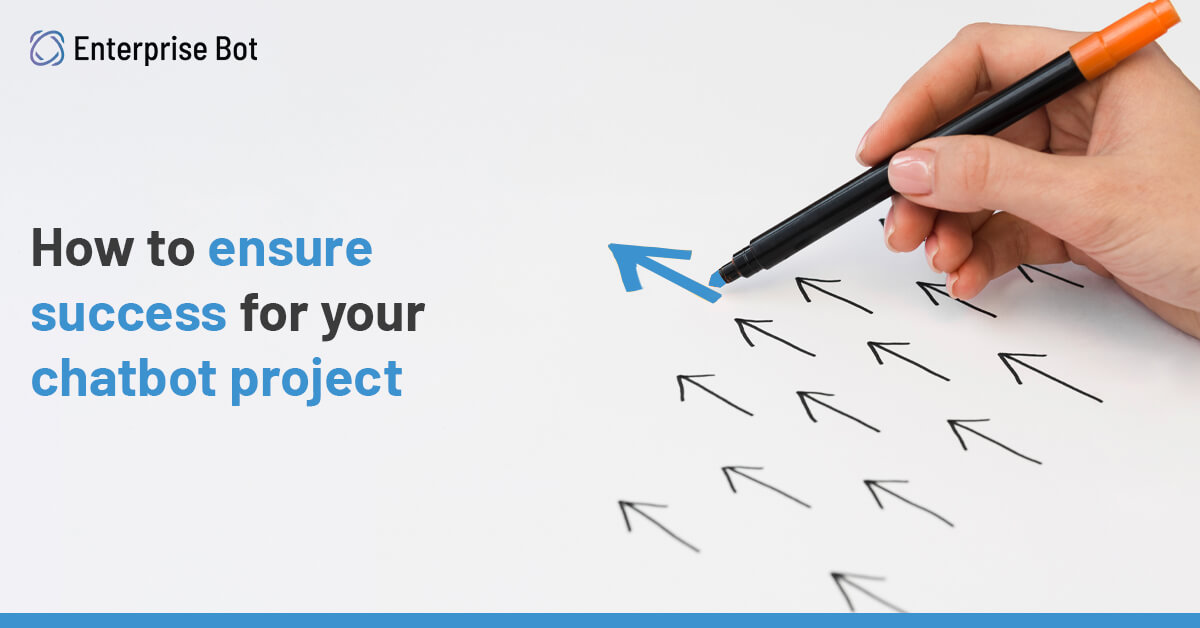Ensure Success for Your Chatbot Projects with Enterprise Bot’s Chatbot Canvas
86% of chatbot projects face some level of failure according to the recent survey by Pega systems.
As a project manager at Enterprise Bot with little technical background, it is critical for me to have an inside-out understanding of the AI project since beginning, and of course, failure is not even an option 🙂. One of the key methods we use to achieve this is the Chatbot Canvas. This has been a fantastic tool that helps to get all stakeholders on one page.
The Chatbot Canvas provides an easy and efficient way to visualize the most critical parts of your project. In addition, the fact that you can fill it out together with all relevant stakeholders throughout the process makes it a very inclusive process.
The idea is simple; most projects do not fail because of complexity or incompetence, but due to lack of clarity between all relevant people who are needed to make the project a success.
This is precisely the problem the Canvas has helped us solve, and we hope it will help you as well to ensure success using Chatbot Canvas.
A Look at Our standard Chatbot Canvas:
Generally, it is a good idea to start with the problem. Within the domain of customer service, for example, these are some of the usual difficulties clients face:
- Limited availability of customer service: only during office hours, no 24/7 solution
- A high volume of repetitive incoming queries blocking customer service agents from performing more complicated tasks
- High costs per conversation
Value Proposition of Your Chatbot
If you like, you can even outline a high-level business in value proposition. It takes 3-10 minutes for a live agent to resolve the issues for a customer depending on the complexity of the task.
In your value proposition, you could mention the following aspects:
- Savings of X amount of money depending on how many FTEs currently work on the defined use cases, how much time it takes them per day to respond to those queries, and how much the average cost of that is in your country or that specific company
- Increase in NPS and customer satisfaction measured through a feedback form at the end of every chat conversation
- Reduction in response time based on how long the usual end-to-end process of responding to L1 queries is
- Standardized responses to user queries
Try to go beyond the standard chatbot advantages like 24/7 availability, mobile solution, self-service though these are, of course, huge advantages by themselves.

Discussing the Use Cases
As a next step, discuss the use cases with the customer service agents. Focus on their major pain points to ensure that your solution will bring relief where it is needed.
Some of the common use cases we have seen are, for instance:
- FAQs
- Product information
- Reset passwords
- Change personal details
- Set up appointments
A lot of times, this might not be readily available, and you might not be able to have the perfect use cases at this stage, but at least get a good overview. Ideally, if you can motivate the respective people to bring this data to the meeting, you will significantly improve the success of the meeting.
Finalizing Key KPIs
After defining the use cases, it is vital to agree on reasonable KPIs (Key Performance Indicators) that match the project scope. These could, for example, be desired accuracy, an increase in NPS (Net Promoter Score), successful back-end system integrations, or a certain number of correctly opened tickets per month.
Starting with Integrations
Once you have a set of use cases and their respective KPIs, you can quickly move on to the integrations. This is one of the significant advantages of using a Chatbot Canvas because even a non-technical person can lay the basis for the technical part of the project. The main idea here is to talk through all the use cases and define the user story end-to-end, including all involved back-end systems like SAP, Salesforce, etc. This will significantly simplify the process architect’s job in the next stages of the project.
Moving on to the Channels
Channels are many times overlooked but can be critical to the success of the project, e.g., behind a login portal with low adoption. If you choose a channel that barely has any traffic and if one of the KPIs is to see the adoption of the chatbot, then the project is destined for failure. Also, it is essential to note whether your use case is B2B or B2C. For B2B companies, we strongly recommend focusing on email as a channel, while for B2C websites and Facebook are great places to get started with the minimal additional effort required on adoption. You can also define what % of queries in that channel you would like the chatbot to try and answer. This is a great way to do a good A/B test and get some real metrics.
Finally…
Canvas fields such as hosting and languages are, of course, essential but quite self-explanatory, so I will not dwell on it too much in this article.
In my experience, the beauty of a Chatbot Canvas lies in its simplicity. It provides you with a 360° view of customers that helps to address and resolve the issues in real-time.
If you want to know more cool tips or tricks to ensure success using Chatbot Canvas, feel free to connect with us, and keep botting. 🙂




